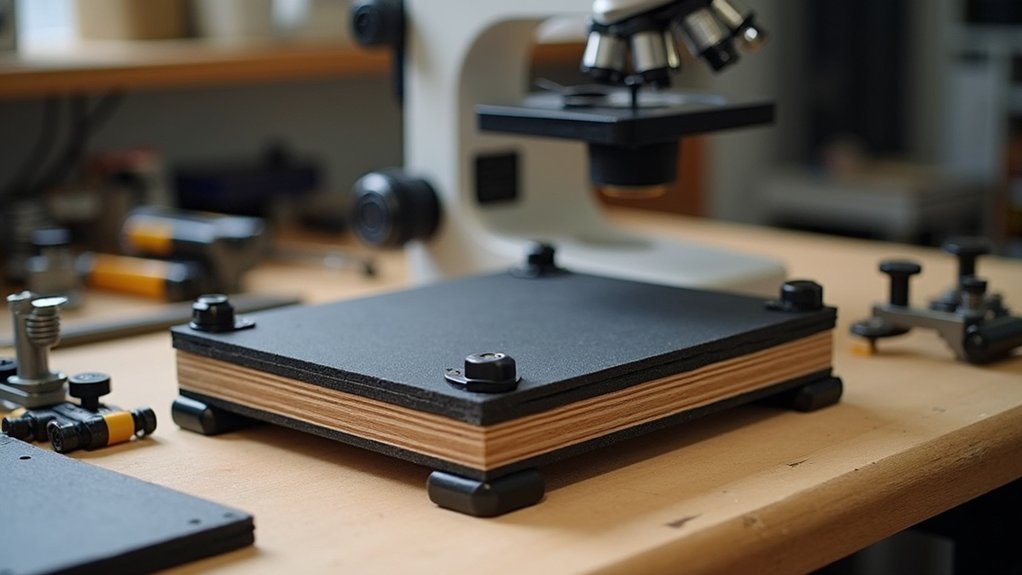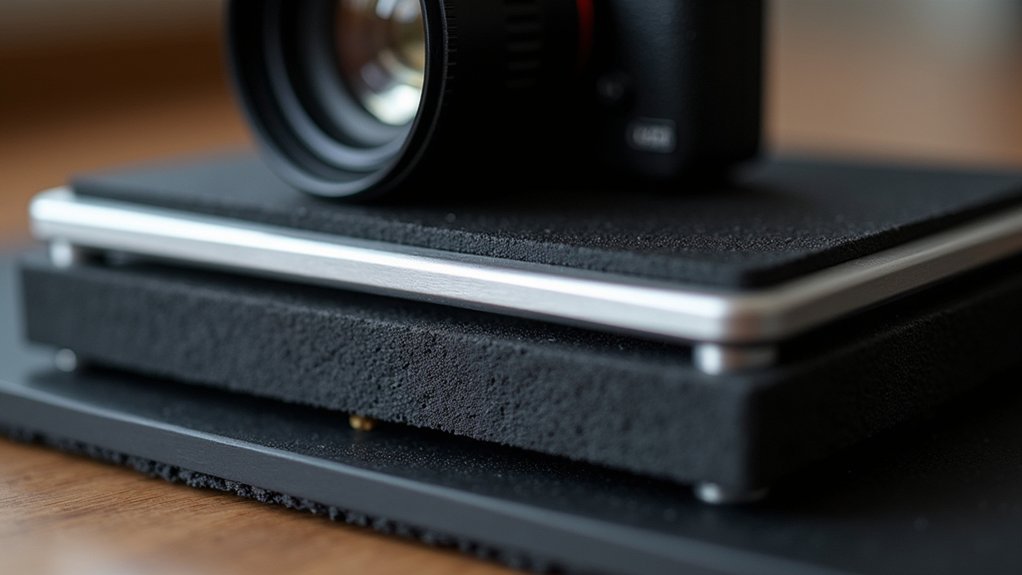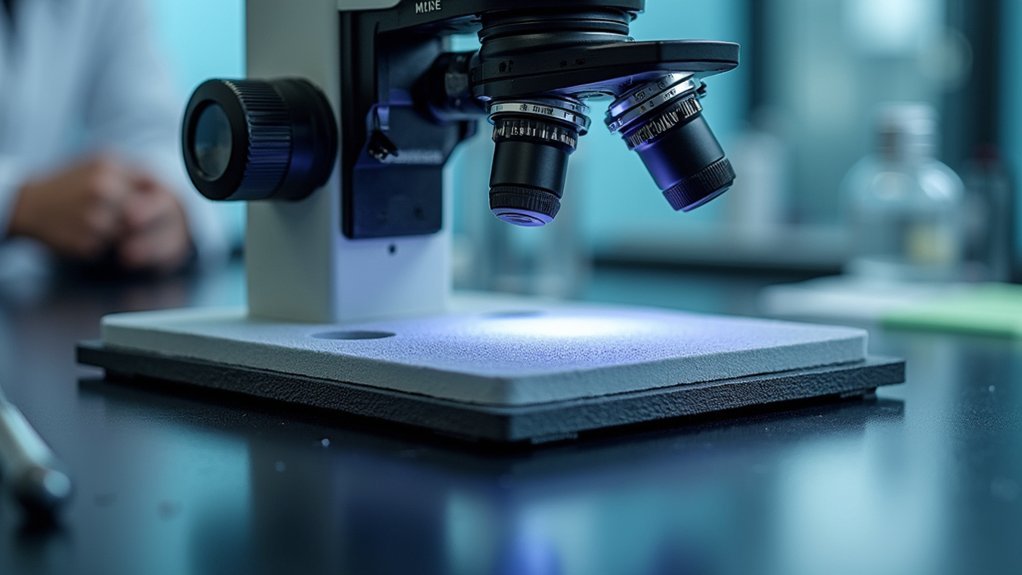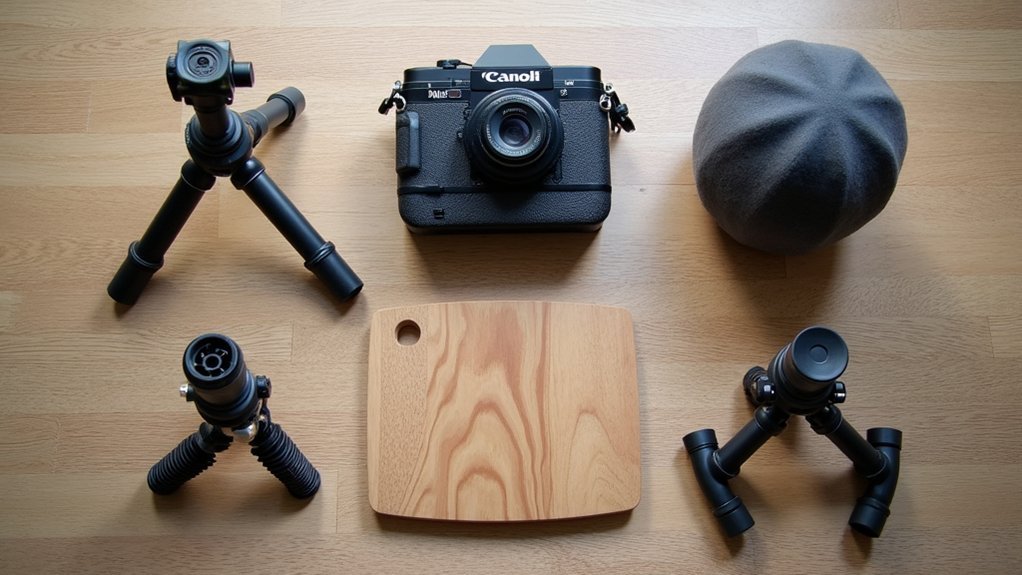To eliminate camera shake, you can build five effective DIY platforms: a heavy MDF base with rubber dampeners, a counterweighted microscope stand for better balance, a dense foam isolation system, a suspended table with shock-absorbing materials, or a vibration isolation setup using concrete or steel. Each option uses readily available materials like plywood, sand weights, or elastomeric isolators to greatly improve image clarity. These simple solutions will transform your high-magnification photography with professional-level stability.
Building a Low-Cost Anti-Vibration Platform for Microscopy

When capturing microscopic images, even the slightest vibration can blur your results and compromise hours of careful work.
You can build an effective anti-vibration platform using heavy materials like MDF or plywood as a solid base to minimize vibrations from your environment.
Place rubber pads between your microscope and the base to effectively dampen vibrations. For enhanced stability, consider a suspended platform design with springs or elastomeric isolators that allows your microscope to move independently of external disturbances.
To further reduce vibrations, add sand or lead shots to increase weight and mass while lowering the center of gravity.
Mass matters in vibration control—adding sand or lead shots increases stability while lowering your setup’s center of gravity.
Always position your setup on a sturdy surface like a heavy workbench for ideal performance. This combination of techniques creates an affordable solution that greatly improves image clarity.
DIY Weight Distribution Methods for Microscope Stability
Beyond simply dampening vibrations, proper weight distribution forms the foundation of microscope stability. When you’re capturing microscopic imagery, even the slightest movement can blur your results.
Creating a custom weight system will help eliminate movement and stabilize videos during critical observations.
- Lower the center of gravity by adding counterweights to your microscope’s base – this simple modification will dramatically enhance stability and minimize vibrations.
- Set up a stable platform using a tripod or custom base to distribute weight evenly across the surface.
- Implement adjustable weights like bagged sand or lead shot for fine-tuning your balance.
- Secure all components including slides, objectives, and camera mounts to reduce shake during detailed examinations.
Foam-Based Isolation Systems for High-Magnification Photography

Vibration dampening represents the critical difference between blurry images and tack-sharp macro photography. Foam-based isolation systems effectively reduce camera shake by absorbing vibrations that compromise your high-magnification shots.
These platforms utilize dense foam materials strategically designed to create a stable foundation for your equipment. You’ll notice immediately improved image quality when implementing these systems, as they prevent even the slightest movements from affecting your macro photography results.
Strategically designed foam platforms eliminate micro-vibrations, delivering instantly sharper macro images under any shooting conditions.
Their lightweight construction makes them convenient to transport between shooting locations without sacrificing stability. Best of all, you can customize these foam platforms to match your specific equipment needs, cutting and shaping the materials to accommodate different camera bodies and lenses.
This adaptability guarantees maximum performance regardless of your setup, making foam isolation an accessible DIY solution for serious macro photographers.
Suspended Table Designs for Eliminating Environmental Vibrations
Although foam platforms work well for many scenarios, suspended table designs offer superior protection against environmental vibrations that can ruin your most critical shots.
These setups employ a flexible suspension system that effectively isolates your camera from footsteps and nearby activities.
You’ll find these advantages compelling:
- Unparalleled stability – The shock-absorbing materials virtually eliminate camera shake, even in high-traffic areas.
- Customizable configurations – Adjustable heights and angles let you adapt to any shooting environment.
- Proper weight distribution – Balanced equipment positioning prevents tipping while maximizing vibration control.
- Budget-friendly construction – Basic materials like plywood and elastic cords make this a cost-effective solution for DIY filmmakers.
Remember to balance your equipment carefully for ideal performance from your suspended table design.
Shock-Absorbing Materials and Construction Techniques for Microscopes

When capturing microscopic imagery, even the slightest vibration can transform crystal-clear details into blurry disappointments. To combat this issue, incorporate shock-absorbing materials like rubber, foam, or silicone into your microscope setup to dampen vibrations and reduce camera shake.
For ideal stability, consider mounting your equipment on a vibration isolation table with springs or pneumatic systems that absorb external disturbances. Heavy bases made from concrete or steel minimize movement by providing a solid foundation.
You can further enhance stability by strategically placing weights or counterbalancing components to redistribute the center of gravity.
Don’t overlook the importance of damping pads specifically designed for optical devices. These specialized mounts prevent environmental vibrations from transferring to your microscope, ensuring your images remain crisp and detailed regardless of surrounding activity.
Frequently Asked Questions
What Is the Best Way to Reduce Camera Shake?
Use a tripod for perfect stability. You’ll also benefit from handheld techniques like keeping elbows tucked. Can’t afford gear? Try DIY counterweight rigs or utilize post-production stabilization software for smooth results.
What Counteracts Camera Shake?
You can counteract camera shake by using stabilizers like Steadicam, adding weight to your setup, employing proper grip techniques, utilizing tripods/monopods, and practicing steady breathing while filming to minimize unwanted movement.
What Device Do You Use to Prevent Camera Shake?
You can use tripods for stationary shots, monopods for mobility, or gimbals for moving footage. DIY options include PVC stabilizers or string techniques. Your choice depends on shooting needs and budget constraints.
How to Reduce Video Camera Shake?
You can reduce camera shake by keeping your elbows close to your body, using both hands for a stable grip, employing tripods or monopods, practicing steady breathing techniques, and making slow, deliberate movements while filming.
In Summary
You’ve now got 5 solid options for tackling camera shake in your microscopy setup. Whether you choose the low-cost anti-vibration platform, weight distribution techniques, foam isolation systems, suspended table designs, or shock-absorbing materials, you’ll see immediate improvements in image quality. Don’t let vibrations ruin your high-magnification work—build one of these DIY solutions today and enjoy crystal-clear, stable observations.





Leave a Reply